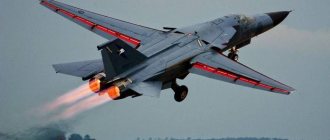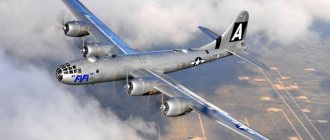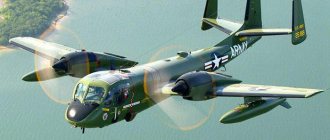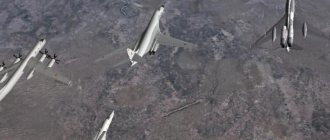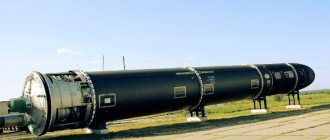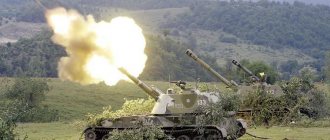Today, only two states on the planet have special air forces, which are called strategic aviation. It is clear that these states are the USA and the Russian Federation. Strategic aviation, as a rule, has nuclear weapons on board and can easily strike enemies located at a distance of several thousand kilometers.
Strategic aviation has always been considered elite. This is how it remains in the eyes of the American, Soviet, and now Russian military command. Submarine missile carriers and ground-based intercontinental missiles, all of them, together with strategic aviation, are part of the so-called nuclear triad. All this power has been the main force in global deterrence for many decades.
Despite the fact that attention to strategic bombers, or rather to their importance, has recently diminished a little, nevertheless, they still remain an important factor for maintaining parity between Russia and the United States.
Nowadays, the list of tasks for which strategic aviation can be used has expanded significantly.
Now strategic aviation has to successfully master conventional types of ammunition along with precision weapons. Both the United States and Russia are quite energetically using strategic bombers to launch missile and bomb attacks in the Syrian Republic.
Today, Russian and American strategic aviation has in its arsenal aircraft designed and built back in the 50-60s of the last century. Not long ago, the United States began work on creating the latest strategic bombers, which are expected to be put into service before 2025.
Work on a similar program is underway in Russia. The new strategic bomber has not yet been given a name. All that is available is the abbreviation PAK DA, which stands for work on the creation of the Advanced Long-Range Aviation Complex. Development is carried out at the Tupolev Design Bureau. The new vehicle is expected to be put into service in the same way as in the United States until 2025.
It is especially emphasized that PAK DA is not a project to modernize currently available strategic bombers. This is the development of a completely new aircraft using the most modern technologies currently available in the aircraft industry.
However, before moving on to getting acquainted with the PAK DA, it would not hurt to get acquainted with the combat vehicles that are currently in the arsenal of Russian and American strategic aviation.
Russia has started building the PAK DA bomber
The leading Russian enterprise in the field of design and production of strategic bombers, Tupolev PJSC, and other enterprises of the United Aircraft Corporation have begun preparations for the creation of the PAK DA, said the head of the Ministry of Industry and Trade Denis Manturov, Interfax writes.
In February of this year, the appearance of the promising long-range aviation complex was finally determined, and all contract documents were signed to launch its production.
The PAK DA should replace the Tu-160, Tu-95MS and Tu-22M3 currently in service. According to official data, the new generation strategic bomber-missile carrier will be designed according to the “flying wing” aerodynamic design (without a tail) and built using stealth technologies. It will be subsonic and will be able to carry more weapons than the Tu-160.
In 2009, the Tupolev Design Bureau signed a contract with the Russian Ministry of Defense for research work under the code “Messenger”, as a result of which a preliminary design of the PAK DA was prepared. The development of a promising long-range aviation complex has been underway since 2013.
Earlier, the head of Tupolev PJSC Alexander Konyukhov reported that the rollout of the first prototype of the PAK DA is planned for 2021-2022.
Yuri Borisov, while in the position of Deputy Minister of Defense of the Russian Federation (now Deputy Prime Minister of the Russian Government), said that the PAK DA could make its first flight in 2025-2026, and the start of serial production is planned for 2028-2029. He emphasized that the promising bomber being developed must carry as many weapons as possible, be invisible and use any airfields.
“Conventional aircraft weapons are being replaced by hypersonic aircraft weapons with a long range and greater accuracy. And a promising carrier aircraft at the turn of 2025-2030 does not need to have such characteristics as supersonic speed. You need to be on combat duty in the air for as long and unnoticed as possible in order to release your weapons at the intended targets without entering the affected area. At the same time, we have coordinated the organization of all work with industry in such a way that preparations for production for the new-look Tu-160 and for the PAK DA are carried out simultaneously. The maximum number of technological operations will be the same. Roughly speaking, the same machines will be used for the production of Tu-160 and PAK DA. In fact, money is spent on preparing production once,” Yuri Borisov previously told Gazeta.Ru.
The PAK DA will be equipped with hypersonic weapons and defensive weapons - air-to-air missiles, which will allow the aircraft to fly without fighter escort.
The main purpose of the PAK DA will be to deliver promising stealthy precision-guided missile weapons to launch sites located several hundred to thousand kilometers from well-protected enemy targets.
At the same time, maximum attention is paid to increasing the level of secrecy of the new vehicle, to detect which the enemy’s infrared and radar means will require approaching at a distance of no more than 80-120 km.
“To this end, a wide range of composite materials and radio-absorbing coatings will be introduced into the airframe design of a promising bomber to reduce the effective reflective surface (the option of using titanium is being considered), while a reduction in the infrared signature will be achieved through the use of non-afterburning turbojet bypass engines with flat rectangular nozzles oriented to the upper hemisphere (from the lower hemisphere of the missile carrier, the nozzles are blocked by the tail load-bearing elements, which significantly limits the detection range of the “warm” jet stream of engines by means of infrared surveillance and sighting systems located on enemy fighters and anti-aircraft missile systems),” explained Gazeta. .Ru” Deputy Director of the Center for Analysis of Strategies and Technologies Konstantin Makienko.
The contract for the creation of an engine for a promising bomber was concluded between JSC United Engine Corporation (part of the Rostec State Corporation) and in June 2022. Co-executors for the project are such holding enterprises as PJSC UEC-Saturn and JSC UEC-STAR and others.
The tender documentation published by PJSC Kuznetsov provides for the development of a turbostarter, an automatic control and diagnostic system, a low-pressure compressor, a low-pressure turbine, a semiconductor spark plug, oil system filters, a fuel system, as well as encrypted design documentation and software for protecting documents representing the state secret.
In total, it is planned to spend 10.1 billion rubles on development, and half of it (5.1 billion) will be spent on creating a low-pressure turbine.
According to the documentation for development work, the promising engine must be protected from the consequences of a nuclear explosion, as well as operate stably and with minimal power losses in the ambient temperature range from minus 60°C to 50°C. The engine life must be at least 8 thousand hours.
The time between overhauls of a promising power plant should be at least 600 hours, but the exact indicators of the service life of the engine and its individual components will be determined during state tests. The PAK DA fuel system must ensure a stable supply of fuel at near-zero and negative overloads down to -2.7 g. The service life of the engine must be at least 12 years, but it must be possible to extend the service life to 21 years.
The electronic engine system (main and backup) must provide forecasting of the condition of the product and its systems, including ensuring a flight lasting 30 hours.
As previously reported, by March 2022, a full-size mock-up of the PAK DA was created at Tupolev Design Bureau. In May 2022, the PAK DA digital model was completely ready. UAC Vice President for Innovation Sergei Korotkov told the media about this. Digitization of the aircraft will allow for maintenance of the PAK DA at all stages of its life cycle, UAC explained.
In the summer of 2022, the corporation defended the preliminary technical design of the PAK DA, moving on to a new stage of work - development. The construction of the apparatus is carried out by the Kazan Production Association named after Gorbunov (a branch of PJSC Tupolev).
It is known that the PAK DA will carry a wide range of weapons on board, including hypersonic missiles. The flight range will be about 12 thousand km, the speed will be about 1000 km/h, and the take-off weight will not exceed 110 tons.
The PAK DA navigation system, as previously reported, will not be tied to satellite signals, but will be guided by astronomical data. This will make the vehicle less vulnerable to electronic warfare.
In addition, as ex-commander-in-chief of the Russian Aerospace Forces Viktor Bondarev said, new missiles are being developed for the PAK DA, the destruction radius of which will reach 7 thousand km. The missiles are planned to be equipped with computer systems capable of analyzing the air and radar situation.
The fate of PAK DA: Russia cannot handle two “strategists”
The promising long-range aviation complex (PAK DA), which is being developed at the Tupolev Design Bureau, will be created using stealth technologies, Deputy Minister of Defense Alexey Krivoruchko said at a meeting on the execution of the state defense order by the Kazan Aviation Plant.
The Kazan aircraft plant is currently loaded with two projects that are most important for the country’s defense capability. Here, the first stage of the strategic missile carrier Tu-160 “White Swan” is being modernized to the level of the Tu-160M. A more powerful aircraft, the Tu-160M2, is also beginning to be built. In these areas, work “is proceeding on schedule, at a number of stages there are slight lags, but there are also advances,” Krivoruchko said.
The situation with the prospects of our Long-Range Aviation, which is the carrier of strategic deterrent weapons, is ambiguous. Veterans YES - Tu-95MS - will soon have to be sent to a well-deserved rest. The Tu-160, although it is currently the most powerful bomber in the world, its avionics already belongs to yesterday. This gap is partially reduced in the Tu-160M modification.
But in the Tu-160M2, in terms of on-board radio-electronic equipment, as the Radio-Electronic Technologies (KRET) concern has repeatedly informed us, a technological breakthrough has been made. According to rough estimates, the combat effectiveness of the Tu-160M2 should exceed that of the basic modification by 2.5 times.
TECHNOLOGY, ENGINEERING, INNOVATION
The appearance of the PAK DA aircraft according to Air & Cosmos magazine According
to a TASS source, the new PAK DA aircraft is designed to solve the same problems as existing Russian long-range bombers. At the same time, it should be superior to the Tu-160 missile carrier in terms of construction and operation costs. However, the source did not specify the cost of the future aircraft and the price of a flight hour.
On December 23, domestic media published statements by the Chairman of the Federation Council Committee on Defense and Security, Viktor Bondarev, who previously served as Commander-in-Chief of the Aerospace Forces. According to him, our country is close to creating an experienced PAK DA. At that time, research work was being completed. Their goal is to create an aircraft capable of replacing all existing Russian long-range aircraft. According to a representative of the Federation Council, the promising bomber will be put into service and enter service with the troops in the second half of the twenties.
Data from an unnamed TASS source, published in November last year, were confirmed at the end of January. In his interview for Komsomolskaya Pravda, Deputy Prime Minister Dmitry Rogozin touched upon the topic of the PAK DA project, indicating the current stage of work and plans for the near future. According to him, the active design phase will begin this year. The official expressed hope that the prototype aircraft will be tested in 2023-24. D. Rogozin also touched upon some technical aspects of the project. He noted that the new bomber will not be similar to traditional aircraft. This will be a “flying wing” - an “aircraft of the 21st century”.
The newest Russian project naturally attracts the attention of foreign experts and the press. Thus, in early February, the French weekly magazine Air & Cosmos published an article about the Russian PAK DA program, in which, among other things, it provided a lot of interesting information. Along with already known data from officials, the publication contained new data supposedly obtained from credible sources.
According to Air & Cosmos, in 2013 it completed the creation of a preliminary design of a new aircraft, which received the working designation “Product 80”. At the end of the same year, Tupolev and the United Aircraft Corporation signed a contract for the development of a technical project. This stage of work took less than three years, and in 2016 the technical design was approved. Since the end of 2014, she has been creating a new engine designed for the PAK DA / Product 80.
It is alleged that the new “Product 80” will be built according to the “flying wing” design. It should have a take-off weight of about 145 tons. Thus, the new aircraft will be almost twice as light as the Tu-160, but at the same time occupy an intermediate position between the lighter Tu-22M3 and the heavier Tu-95MS. The power plant will consist of two turbojet engines under the working title “RF Product”, created on the basis of “Izdeliye R” - NK-32-02. The total thrust of the two engines will be 46 tons. Due to such a power plant, the aircraft will be able to fly at subsonic speeds at a range of up to 15 thousand km.
It should be recalled that various assessments of the technical characteristics of the future PAK DA have appeared since the announcement of the start of this program. Some figures were subsequently mentioned to officials, but the full picture, based on information from reliable sources, is still missing. To what extent the Air & Cosmos data corresponds to the real PAK DA project is still anyone's guess. A confident answer to this question can only be given in a few years, when the necessary information becomes available.
At the end of February, already known data on the future construction of promising aircraft for long-range aviation were confirmed. The site for the assembly of such equipment will be the Kazan Aviation Plant named after. Gorbunova. Deputy General Director of the enterprise Nikolai Savitskikh told the press that the technical appearance of the PAK DA aircraft has already been protected, and an agreement has been concluded for development work with the subsequent construction of a prototype. In this document, KAZ is indicated as the manufacturer of the prototype.
According to N. Savitskikh, work under the program “Advanced Aviation Complex for Long-Range Aviation” will load the production capacity of the Kazan Aviation Plant for the next decade. At the same time, the enterprise is experiencing noticeable problems with personnel training. Last year, KAZ specialists prepared a comprehensive targeted program for training and securing personnel who will work in the construction of Tu-160 and PAK DA aircraft. The cost of the program is 2.6 billion rubles.
At the time of the Deputy Director General’s statements, the program was being approved by the Russian government. In addition, within the framework of the relevant federal program, production facilities are being modernized, including those that will participate in the construction of PAK DA aircraft.
The latest news about the PAK FA program was announced just a few days ago. On May 24, President of the United Aircraft Corporation Yuri Slyusar, speaking at the international economic forum in St. Petersburg, touched upon the topic of the name of the future long-range bomber.
The head of the UAC recalled that the aircraft is being developed. In this regard, the new car should bear the “historical” Tupolev name. At the same time, however, the head of the corporation did not specify which numbers would be combined with the traditional designation “Tu”.
***
The Russian project “Advanced Long-Range Aviation Complex” is currently one of the most interesting topics in the context of current and future rearmament. At the same time, due to its special importance and significance for national security, this project is one of the most secret. Officials from time to time raise the topic of ongoing work and announce certain information, but at the same time do without any special details. As a result, even several years after the start of work, only the most general features of the future strategic bomber are known.
Earlier it became known that the promising PAK DA bomber, being developed, is intended to replace two modern models at once. In the distant future, machines of this type will displace the relatively old Tu-95 and Tu-22M3 from long-range aviation, taking over all their tasks. The possibility of replacing the Tu-160 aircraft has been discussed in the past, but the planned mass production of the Tu-160M2 type has likely led to the cancellation of such plans. Thus, from a certain time on, the basis of long-range aviation will be the deeply modernized Tu-160M2 and completely new PAK DA.
It is already known that the PAK DA project is based on a new concept for domestic strategic aviation. It is proposed to build a “flying wing” aircraft with subsonic flight speed and reduced visibility for enemy surveillance equipment. The special layout of the airframe with the largest possible fuel tanks and efficient engines of sufficient power will ensure the ability to fly at a range of up to 15 thousand km.
The main armament of such an aviation complex will be long-range cruise missiles with conventional or special warheads. The significant flight range of the missiles will allow the PAK DA to attack specified targets without entering the enemy’s air defense coverage area. Certain stealth technologies used on both the aircraft and its missiles should dramatically reduce the likelihood of timely detection of incoming bombers or their weapons. All this will have a positive impact on the effectiveness of the strike.
According to known data, research and development work on the PAK DA topic started about ten years ago, at the end of the 2000s. Over the course of several years, Tupolev and related enterprises formed the main provisions of the future project. At that time, reports appeared about the possibility of building and testing the first prototype aircraft already at the end of the tenth years.
However, later plans changed. In 2015, a decision was made to resume serial production of the existing Tu-160 with the subsequent creation of a new modification of such an aircraft. In this regard, the work schedule for the PAK DA program was revised. The start of preparation of technical documentation for the new aircraft has shifted to the right by several years. The first flight of the prototype was postponed to the first half of the twenties. It should be noted that there is another interpretation of the events of recent years. According to it, the decision to build new Tu-160s was a consequence of certain problems with the PAK DA and the impossibility of producing promising production vehicles in the desired time frame.
Despite all the expected and possible difficulties, the development of the “Advanced Long-Range Aviation Complex” continues. It has already become known that the project has entered a new stage, prior to the construction and testing of experimental equipment. The moment when the PAK DA is put into service and the first production samples are accepted is still in the distant future, but is getting closer every day. Available information about ongoing work allows us to look into the future with cautious optimism. Everything suggests that in the second half of the next decade, Russian long-range aviation will replenish its fleet with completely new models.
Source: https://topwar.ru/ Author: Ryabov Kirill
Position and prospects of modern strategic aviation of the USA and the Russian Federation
American strategic bombers
Today, American strategic aviation has the B-52 and B-2 Spirit heavy bombers, and in addition another aircraft: the B-1B Lancer bomber. It was specially developed to launch nuclear strikes on enemy territory. However, in the mid-90s, the American strategic forces had to say goodbye to him, as he was removed from their composition.
B-1B bombers are considered similar to the Russian Tu-160 jets, although they are inferior to the latter in size. According to available information provided by the American State Department in January of this year, 12 B-2 bombers, as well as 73 B-52 aircraft with the N modification, continue to be on combat duty.
Today, the B-52 bombers, developed back in the 50s and 60s, are the basis of the strategic forces of the United States. These aircraft carry AGM-86B ALCM cruise missiles, which can carry nuclear warheads. Bombers have a flight range that exceeds 2,750 km.
B-2 Spirit bombers are the most technologically advanced and most expensive aircraft on the planet. Their price is significantly more than the astronomical two billion dollars. The first bombers were manufactured back in the 80s. However, a decade later the program had to be closed. As it turned out, even the United States could not cope with such a high cost.
During this time, they managed to produce twenty-one B-2 vehicles. The bombers are made using stealth technologies that have the lowest electronic paramagnetic resonance in the world. It is significantly lower than the small stealth aircraft of the F-35 and F-22 types. B-2 Spirit bombers have only free-fall bombs, as a result of which they are ineffective against enemies who have advanced air defense systems at their disposal. In particular, the Russian S-400 air defense system can easily detect B-2 bombers.
Thus, the B-2 Spirit aircraft are rather “strange” bombers. Despite the astronomical prices, their combat effectiveness in the event of a possible nuclear conflict would be very ambiguous.
B-1B Lancer bombers are also not capable of arming themselves with strategic cruise missiles. Although, to be more precise, the US Army arsenal currently does not have such weapons suitable for these aircraft.
These days, these bombers are used primarily for strikes using conventional munitions. It is possible that they can be armed with free-falling bombs with nuclear warheads. However, it is unlikely that these bombers would be able to penetrate deep into the territory of an enemy with serious air defenses.
What prospects does American strategic aviation have? In 2015, aircraft manufacturer Northrop Grumman, which created the B-2 Spirit, won another tender announced by the United States Department of Defense to build new American strategic bombers, planned to be called the B21.
Work on the development of these machines began to be carried out under the LRS-B program. The abbreviation stands for Long-Range Strike Bomber, which in turn can be translated as “Long-Range Strike Bomber.” Today it is no longer a secret to anyone what the new bombers will look like.
Just like the B-2 Spirit, the new vehicle will be built according to the “flying wing” design. The military department demands that the new aircraft be even less visible on radar, and its cost could exceed the American budget. They intend to begin producing the latest bombers in the next decade. The American military is currently planning to purchase a hundred of the newest B21s, and in the future completely replace them with B-52s and B-2s.
The new bombers, as conceived by their developers, will be able to carry out combat missions, both controlled by a crew and unmanned. The total cost of the project is $80 billion.
Russian strategic bombers
The Russian Air Force currently has two heavy bombers: the Tu-95 MS modification and the “White Swan” Tu-160. The most popular strategic bombers in the domestic Air Force were the turboprop T-95 “Bears”, the first flight of which was carried out during the time of Stalin in 1952. Although, it should be emphasized that the bombers used today are related to the “M” modification and were created back in the 80s.
Thus, it turns out that the main arsenal of the Tu-95 is even younger than the American B-52 bombers. We can add to this that in recent years they have already begun to modernize these aircraft to the MSM modification. It is planned to modernize 35 aircraft, and this in turn will facilitate the adoption of the latest X-101/102 cruise missiles.
With all this, even the “Bears” that have not undergone modernization will be able to take on board the Kh-55SM missile system with a range of up to 3500 km, as well as the potential for installing nuclear warheads on them. Kh-101/102 missiles can travel up to 5,500 km. Today the Russian army has 62 Tu-95 units.
The second aircraft currently in service with the Russian Air Force is the Tu-160. In general, these are supersonic bombers with variable wing geometry. The Russian Air Force has sixteen such aircraft. These supersonic bombers can also be armed with cruise missiles of the Kh-101/102 and Kh-55SM types.
Today, we have already started producing modifications of Tu-160M type aircraft. These are the first bombers of this modification, which were transferred to the Russian Aerospace Forces in August of this year. These bombers are equipped with new systems with on-board electronics, and in addition, work is underway to create modifications such as the Tu-160M2. On the latest modifications of vehicles, along with cruise missiles, the use of free-fall bombs can also be used.
Despite the ongoing work to modernize the Tu-160, the Tupolev Design Bureau is promoting the project with the new PAK DA bomber. As already mentioned, it is planned to launch their serial production until 2025.

